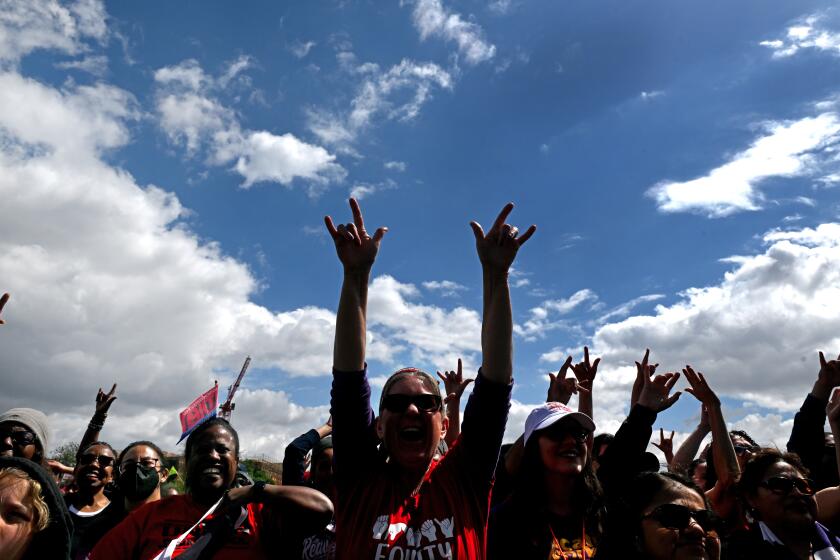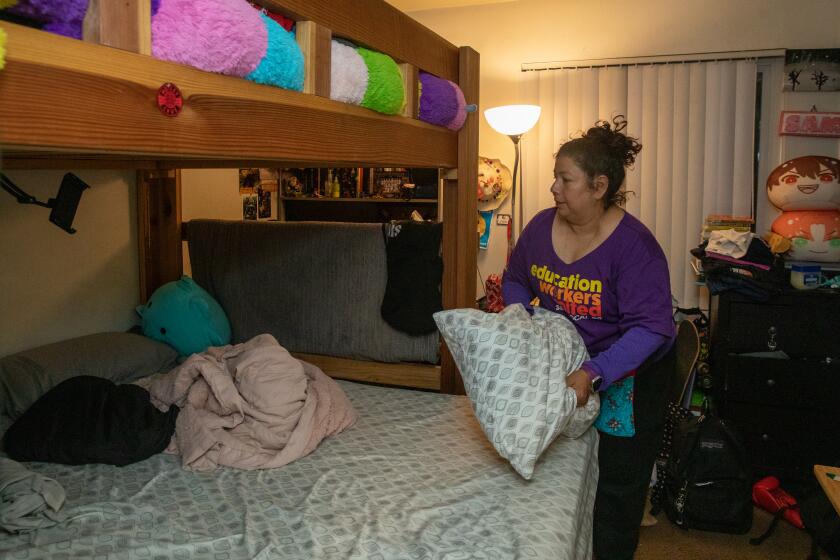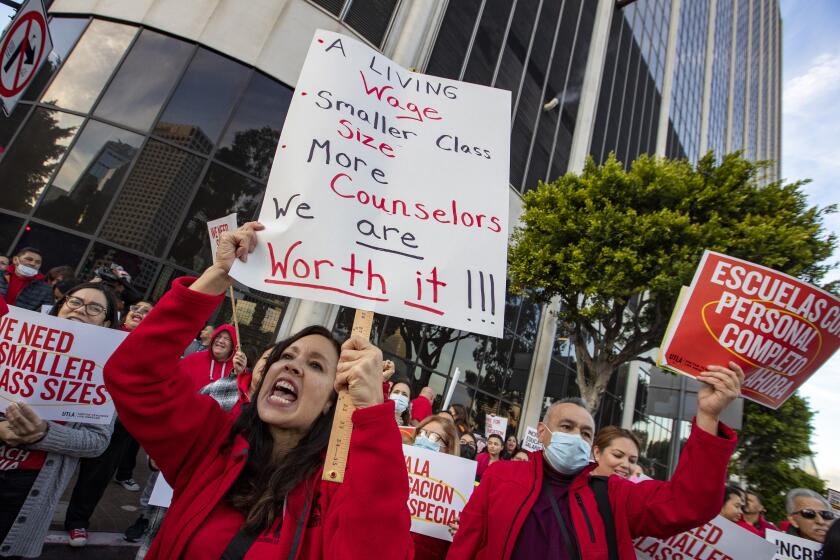As talks with teachers heat up, LAUSD budget shows a higher ending balance, with caveats

- Share via
For months, the Los Angeles Unified School District had been saying that, despite an ending balance of $4.93 billion for the current school year, the district could be at financial risk in the future.
Part of that equation changed Monday, when the district updated that figure to $5.12 billion — while also stating the system’s potential financial risk is unchanged and the available money for employee raises may be tighter than before.
Welcome to the complicated world of finance in the nation’s second-largest school system.
The teachers union, which is negotiating a contract with LAUSD, says the picture is much simpler: The district has bountiful financial reserves and can afford its demands for a 20% pay raise over two years.
Here is a look at district finances and the simmering labor troubles a week after a strike shut down schools for three days — and after Local 99 of Service Employees International Union, which led the walkout, reached a tentative deal with L.A. Unified.
The agreement comes after L.A. Mayor Karen Bass intervened to mediate the protracted dispute that led to a three-day strike and LAUSD school closures.
How is the district’s financial health?
The Board of Education on Monday reviewed the district’s second interim report — a budget update required by state law as a way to ensure no school system could go bankrupt without public disclosure and taking steps to prevent it.
The good news is that district officials have certified to the Los Angeles County Office of Education that the district will remain solvent this year and the following two — the limit of the specified time span covered by the required report.
More good news came when Chief Financial Officer David Hart, in response to a board member’s question, said the district would remain solvent even when anticipated contract settlements with the various employees are factored in. But there are limits to what the district can afford, he said.
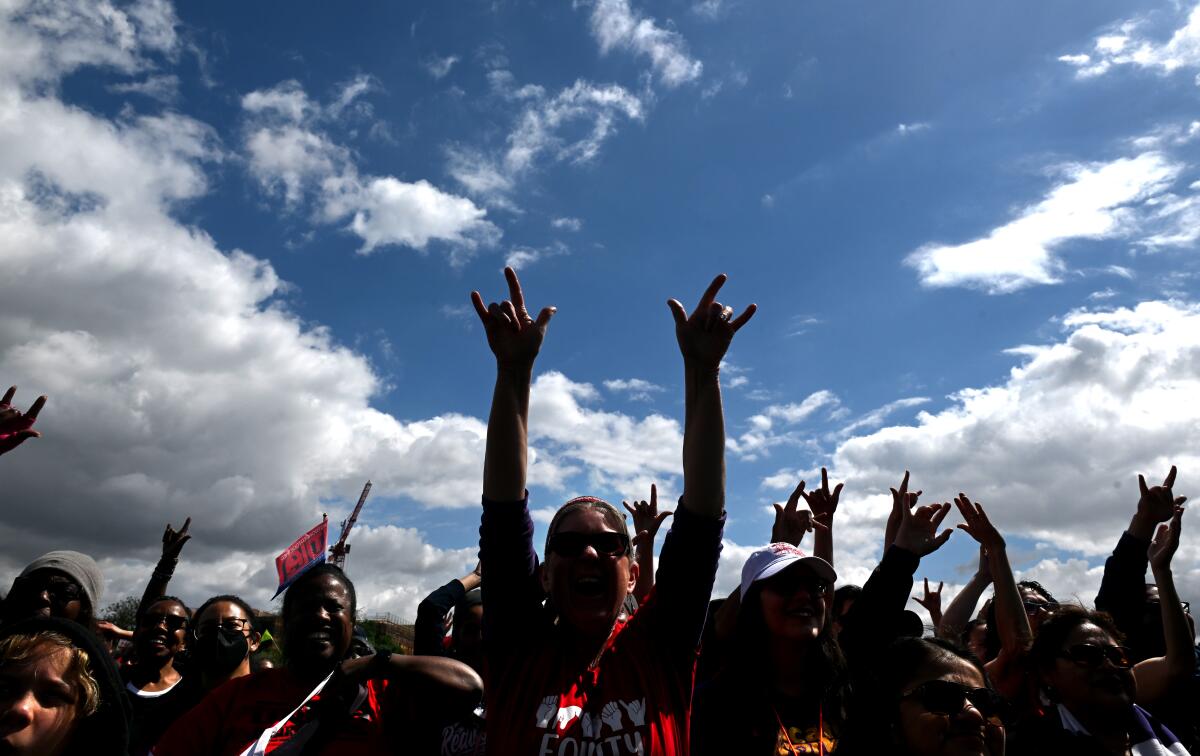
How big is the district’s ending balance and why does this matter?
Until this week, the official ending balance on June 30 was an estimated $4.93 billion. That has increased to $5.12 billion. The ending balance is spendable financial worth that L.A. Unified has left over at the end of the fiscal year. Not all of this is readily usable; the figure includes the value of all inventory, and revolving cash, which add up to $43 million. But there’s still much spendable money left over.
However, officials said the amount of “unassigned” funds has declined, from $139.7 million to $95.9 million, because of a loss in the value of investments.
The rest of the $5.12 billion has been designated for other purposes — programs and expenditures approved by the school board or superintendent. This includes $700 million set aside for extra support for the schools that are struggling the most. Much of this funding goes to extra staffing.
L.A. Unified has been flush in recent times with one-time funding from COVID relief and from record state tax revenues that are not necessarily stable from year to year. But this surplus created an unusual challenge. School systems are allowed to have an unallocated reserve of no more than 10%. When the unallocated reserve grows higher than 10%, the money must be returned to the state.
Officials don’t want that to happen, so they will record a purpose for these funds rather than lose them. That also means these funds can be redirected for a higher-priority purpose should the need arise.
Can the district afford the contracts going to workers?
L.A schools Supt. Alberto Carvalho said he won’t agree to a contract that the district cannot afford.
Ongoing raises into the future must be sustained.
Local 99 just won a significant raise for the 30,000 employees it represents — some of the lowest paid in the school system, who include teacher aides, special education assistants, bus drivers, security aides, custodians and food-service workers.
For many L.A. Unified workers who are on strike, the crux of the fight is the ability to live decently in L.A., where the cost of housing exerts a brutal burden.
The union sought a 30% raise, but not all workers are getting that much, while some are getting more. The greatest percentage benefit is going to the lowest-paid workers, especially those who have been with the district the longest. The structuring of the raise over several years is a key factor in making it affordable, according to L.A. Unified.
The strike cost the district $100 million because of lost student attendance funding and lost school days, officials said. And striking employees lost three days of pay. Student attendance had not fully recovered by Friday; the day after the strike ended, only 71% of students attended school.
Educators want a 20% raise but says they’re also committed to demands that represent the union’s social values, such as solar panels and electric buses.
How much would the labor contracts cost?
This information is emerging.
The district costs out health benefits at $20,000 per employee — the cost of dependents is factored into that. The Local 99 contract is going to increase the number of employees who receive health benefits.
Before the strike, the district stated that its offer to Local 99 would cost $595 million for next year alone. The union rejected that offer. The final agreement presumably costs more.
“Our research team calculates the agreement is about 7% of the district’s budget,” Local 99 spokesperson Blanca Gallegos said.
A 1% raise across the board for all employees would cost about $62 million per year, Hart said.
United Teachers Los Angeles is almost certain to challenge that calculation, but the money adds up, especially with employees seeking larger-than-usual raises to offset inflation and address the high cost of living in Los Angeles.
This across-the-board yardstick is relevant because district unions historically have had “me too” contracts. Generally, the teachers union has fought for the biggest raise it can get and then the other unions receive about the same increase — even if they had settled before UTLA.
This time around, Local 99 settled first and set a high bar — but “me too” may not apply, as terms are bargained with not only teachers but also administrators, clerical workers, Teamsters and two police unions.
The district is budgeted this year to spend about $10 billion combined in its restricted and unrestricted budgets — so a $5.12-billion ending balance seems like a lot — although this budget and the ending balance could change considerably once retroactive raises for employees are applied.
The budget report is current only through Jan. 31, prior to labor agreements.
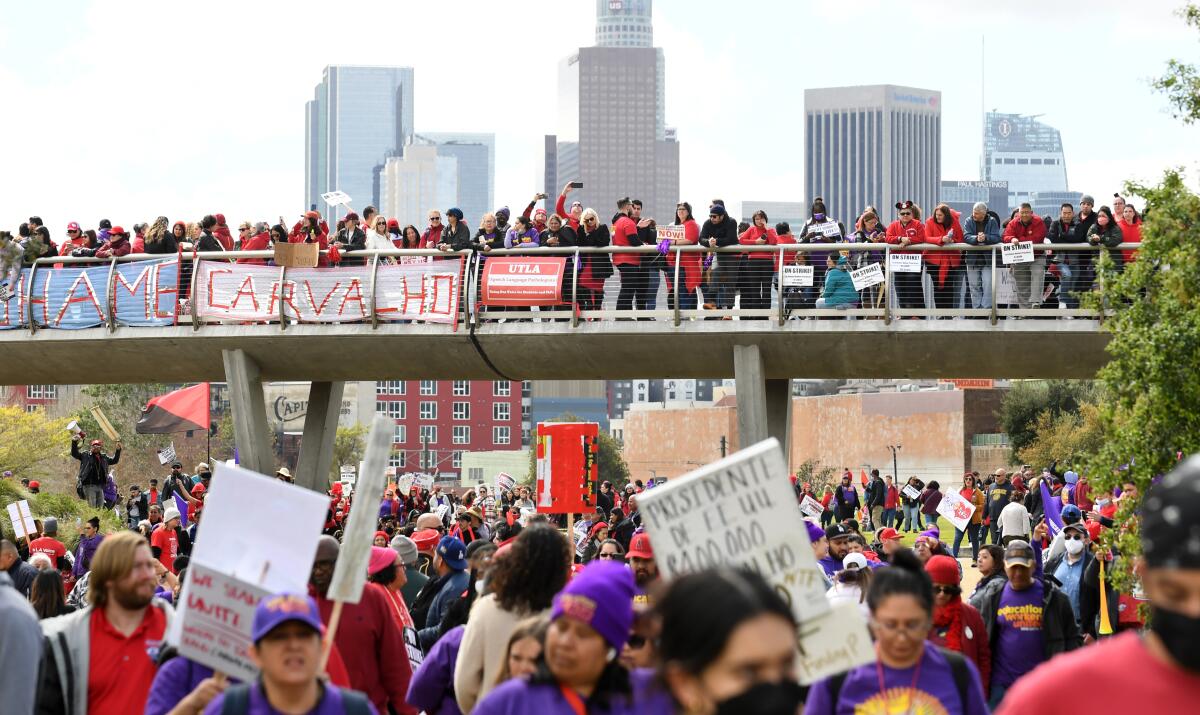
What are the prospects of a teachers strike?
Other employee unions have yet to settle, including UTLA, which represents about 35,000 teachers, therapists, counselors, nurses and librarians.
UTLA joined Local 99 in the latter’s three-day strike last week, resulting in the closing of schools. Barring a settlement, UTLA could stage its own strike.
“This strike built great solidarity between SEIU Local 99 and UTLA members,” Gallegos said. “Members would ultimately need to vote on a strike, but there is a general sense that school workers are ready to stand with teachers to continue moving forward for our schools and students. The contract allows for sympathy strikes.”
UTLA could justify a strike with little notice by accusing L.A. Unified of unfair labor practices — which is what Local 99 did.
However, if UTLA waits for the state’s established negotiation process to play out, reaching a job action would take time. UTLA and the district remain in active negotiations. These negotiations would first have to falter and fail. The union would then declare impasse, and a mediator would be called in. If mediation failed, a fact-finding process that involves an appointed panel would unfold.
Only at the end of this process could a traditional strike, called an “economic strike,” occur.
More to Read
Sign up for Essential California
The most important California stories and recommendations in your inbox every morning.
You may occasionally receive promotional content from the Los Angeles Times.
